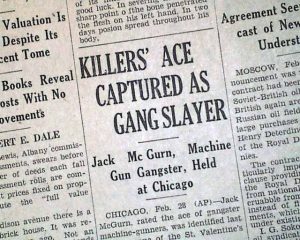“The frail child in the tattered dress stands next to a large carved wooden chair, her hand resting on the arm for support. A large gash runs from her forehead to her cheek; her arms and legs are evidence of repeated and severe abuse.”1 It’s easy to assume that this came straight from the script of a horror movie, but it was the harsh reality for young Mary Ellen Wilson, a nine year old girl who was so beaten up and malnourished that she only looked about half her age. Although the worst part about it was that her guardian, the person that was expected to provide love and care, was the perpetrator of this little girl’s tortured condition, and law enforcement was only able to help with one hand tied behind its back. Help for children like Mary Ellen was hard to come by because, in the year 1874, parents could raise and discipline their children as they pleased. Parents of the time lived with the mindset that the government had no right to interfere with their parenting, but the Mary Ellen Wilson case opened the eyes of many, including Henry Burgh, who initiated a change and put together a team to end the violence.2
Before 1874, no one had actually ever seen young Mary Ellen. She lived in isolation for at least six out of the nine years of her lifetime. Luckily, her suffering was brought to light when neighbors reported the crying of a child without ever actually seeing the child. Due to the lack of child protection laws, there was not much officials could do about the situation. But once missionary Etta Wheeler caught wind of what was going on, she was determined to rescue Mary Ellen. Etta Wheeler is often overlooked when the Mary Ellen Wilson story is told, but without her kind efforts, Mary Ellen may have never gotten the help she needed.3
Wheeler paid many visits to Mary Ellen’s home, most of which were unsuccessful. and she was only able to catch short glimpses of the battered child. She then requested help from local organizations and charities that were known for providing essentials for children in need, but they did not possess the authority to intervene. Finally, Wheeler turned to someone who was known to take action for causes that he believed in, Henry Burgh.4
Henry Burgh was a rich, well-known diplomat famous for being the founder of the American Society for the Prevention of Cruelty to Animals and for getting overwhelmingly involving in things that he believed in. After working with Wheeler to learn more about Mary Ellen’s situation, he reached out to attorney Elbridge T. Gerry. Gerry was eager to get the ball rolling as well, and within 48 hours, Gerry and Burgh had developed a case and asked Wheeler to testify.5 In attempts to gather more information of his own, Burgh sent investigators to Mary Ellen’s home. After seeing the horrific conditions that Mary Ellen was in, law enforcement soon made the decision to remove the young girl from the dangerous home. Although there were no specific laws concerning child abuse, these circumstances were so special and concerning that an executive decision was made. They took the young, battered girl out of her death trap of a home and comforted her in a blanket. She was so oblivious to the outside world that when a police officer gave her a peppermint stick for comfort, she tried to use it for self defense.6

It was now time for Mary Ellen’s case to go to court, and who better to tell the Mary Ellen story than Mary Ellen herself? She was able to testify for herself in cour,t and gave the real and terribly sad testimony that follows: “My name is Mary Ellen…I have no recollection of ever having been kissed and I have never been kissed by momma. I have never been taken on mommas lap…I never dared speak to anybody, because if I did I would get whipped; I have never had any more clothing than I have on at present…;I have seen stockings and other clothes in our room, but I am not allowed to put them on; whenever momma went out, I was locked up in the bed- room;…I don’t know for what I was whipped; momma never said anything when she whipped me; I do not want to go back to live with momma because she beats me so.”7
After a legal battle, Mary Ellen was permanently removed from her home and given her justice, but this was not enough for Henry Burgh. Burgh was determined to create an organization to protect future children from that kind of abuse. He quickly founded The New York Society for the Prevention of Cruelty to Children (NYSPCC). NYSPCC was the first child protective organization in the entire world. It has since influenced over 300 different organizations and eventually it led to the development of Child Protective Services.8
- Mary Renck Jalongo, “The Story of Mary Ellen Wilson: Tracing the Origins of Child Protection in America,” Early Childhood Education Journal, Vol. 34, no.1 (August 2006): 1. ↵
- Howard Markel, “Case Shined First Light on Child Abuse,” New York Times, December 14, 2009, http://www.nytimes.com/2009/12/15/health/15abus.html. ↵
- Gerald Mallon, “From the Editor: The Legend of Mary Ellen Wilson and Etta Wheeler: Child Maltreatment and Protection Today,” Child Welfare vol. 92, no.2 (March 2013): 9. ↵
- John E.B. Myers, “A Short History of Child Protection in America,” Family Law Quarterly, Volume 42, no.3 (Fall 2008): 451. ↵
- Mary Renck Jalongo, “The Story of Mary Ellen Wilson: Tracing the Origins of Child Protection in America,” Early Childhood Education Journal, Vol. 34, no.1 (August 2006): 2. ↵
- Eric Shelman, The Mary Ellen Wilson Child Abuse Case and the Beginning of Children’s Rights in 19th Century America (Jefferson, N.C. : McFarland & Company, 2005), 16. ↵
- Mary Renck Jalongo, “The Story of Mary Ellen Wilson: Tracing the Origins of Child Protection in America,” Early Childhood Education Journal, Vol. 34, no.1 (August 2006): 1. ↵
- John E.B. Myers, “A Short History of Child Protection in America,” Family Law Quarterly, Volume 42, no.3 (Fall 2008): 451-452. ↵



57 comments
Danniella Villarreal
It is truly sad to know that this child didn’t get to experience love from her mother, but I am happy to know this brought awareness to child abuse. This article hits a soft spot in my heart. I am happy to know that now there are organizations to help children who have mothers like Mary Ellen’s did. It is heart breaking to know that Mary Ellen had to go through so much mistreatment as a child but her courage was able to shield many other children. Over all this was a very interesting article to read.
Rebeca Escobar
What this poor child went through is disheartening, but I am relieved to know she was rescued from that horrible place some people would call “home”. However, it is important to remember the many children out there who have never received help and who continue to live in the midst of these monstrous parents. I don’t know how anyone could lay a hand on someone so innocent and helpless; I hope God and the world watch over these children who deserve nothing more than love and kindness, and that the monsters who have harmed or taken the lives of these children will face extreme consequences and judgment. I am happy for Mary Ellen, and I hope her story teaches many to never overlook these cases.
Engelbert Madrid
It is disappointed to know that there are cruel people in this world that could have the anger to hit young children, especially with their own children. The case of Mary Ellen Wilson is sad to read, because children are fragile and they should not go through tough punishments for any reason. Also, the heart of a child is sensible. They retain many things in their hearts that could damage or benefit them; therefore, adults should always try to build a healthy relationship with children.
Aneesa Zubair
Wow, I can’t believe this story isn’t told more often! I’ve never heard of the Mary Ellen Wilson case before. Her case was a precedent for child protection laws, thanks to Etta Wheeler and Henry Burgh. Mary Ellen’s testimony about the abuse she suffered was heartbreaking. I do wish the article went into greater detail about the legal battle and the founding of the NYSPCC, though. I’m glad Wheeler and Burgh decided to act on the horrible treatment and conditions they saw instead of keeping to themselves as most people had done; if they hadn’t challenged it, we might not have child protection laws today.
Bictor Martinez
It is crazy to see how times have change. The parents back in the day did as they pleased in how they thought most effectively would help their children mature and grow. Henry Burgh and Etta Wheeler are great people to be able to get Mary Ellen out of her misery. It is sad that Mary Ellen had to be the victim of mistreatment at such a young age however, her bravery was able to protect many other children through the eventual development of Child Protective Services. Great article!
Eric Ortega Rodriguez
Wow, this is truly a sad story. I feel bad for Mary Ellen since she never got to experience her mother’s love. However, I am glad that Elbridge T. Gerry was able to make a case out of this to call child abuse to attention. It is also great to hear that Henry Burgh was able to use this case as a stepping stone to help put an end to child abuse. Overall, a very well-written article with a good topic selection.
Christopher Vasquez
This is such a sad story. Although I am aware that people like her mother exist, it’s still difficult to believe that a mother would treat her own child this way. It is a great thing what Etta Wheeler, Henry Burgh, and Elbridge T. Gerry did for Mary Ellen. Each contributed in their own way and influenced the world for the foreseeable future; because of these three individuals that saved Mary Ellen, the world now has a child protection organization of some kind in nearly every country, each with the task of ensuring the safety of children to the best of their abilities. These people have truly changed the world.
Jocelyn Moreno
I’m glad someone stepped in and decided to help this poor child then leading them to lead all children across the nation. It’s so crazy how Mary was treated, never feeling an ounce of love or affection from her parents or anyone. This story broke my heart, I’m glad they installed Child Protective services.
Marina Castro
Although this article was very interesting and informative to read, it was also heartbreaking. It is sad to read about children lived their lives in old societies. Today it is unspeakable and unimaginable to say that someone’s parents would treat their kids that way. The only heart whelming part was that she was finally helped and taken out of her misery.
Belene Cuellar
I can not imagine how cruel someone is to abuse and torture their own child. Never showing them any love and nurturing them is just so evil. I can’t believe the government allowed such treatment go on for such a long time. I’m glad they managed to get her out of that house safely before it was too late. Hopefully she was able to find a home where she was loved and taken care of.